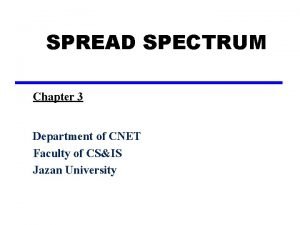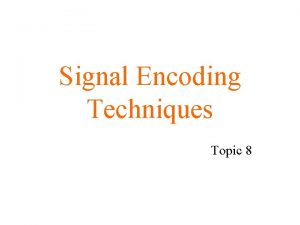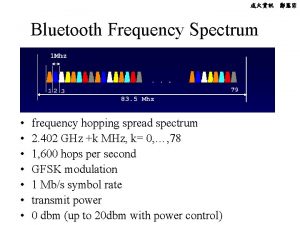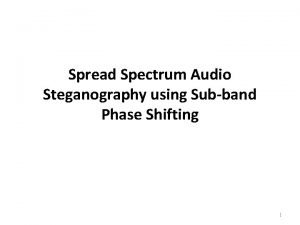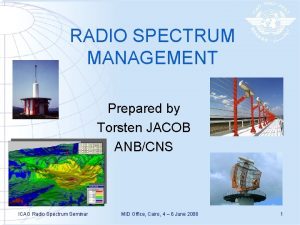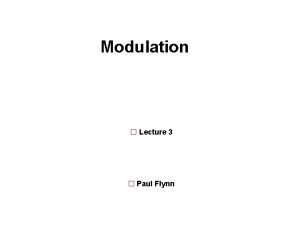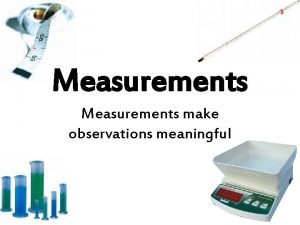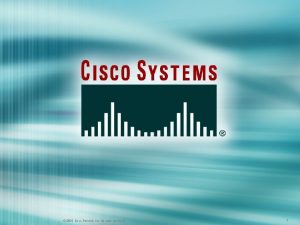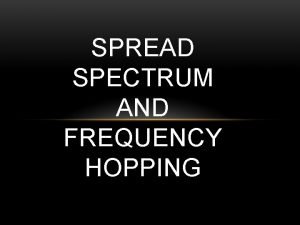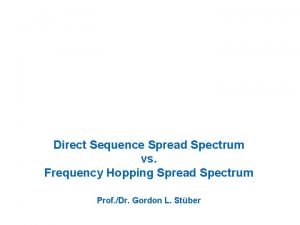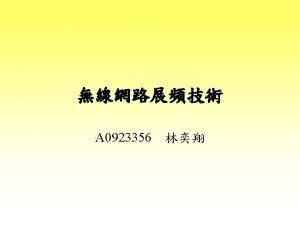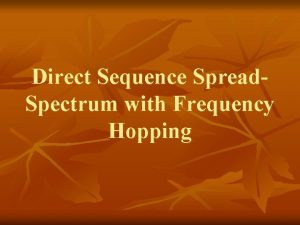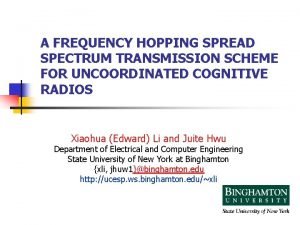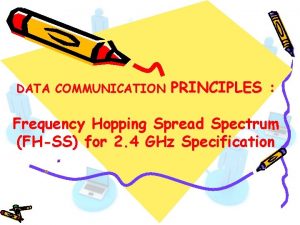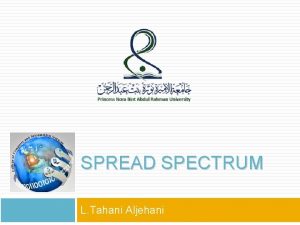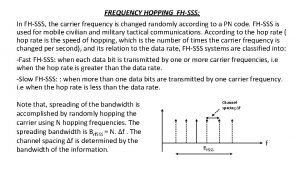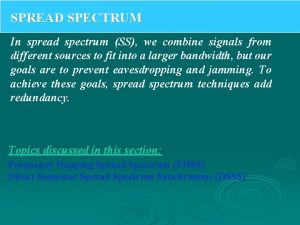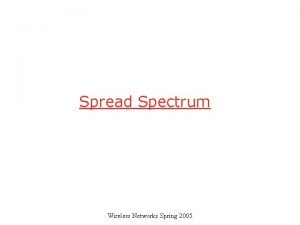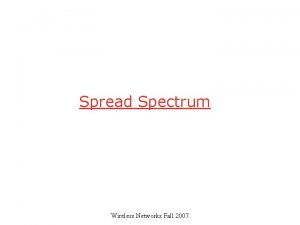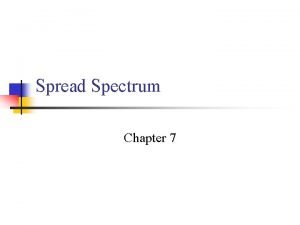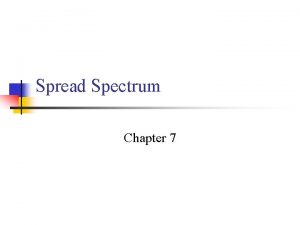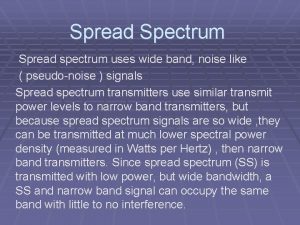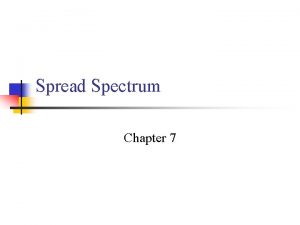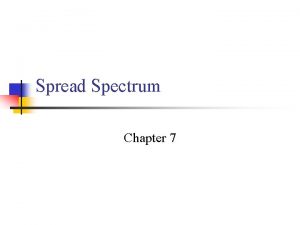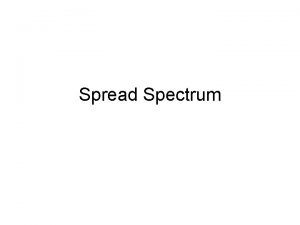Direct Sequence Spread Spectrum vs Frequency Hopping Spread




















- Slides: 20

Direct Sequence Spread Spectrum vs. Frequency Hopping Spread Spectrum Prof. /Dr. Gordon L. Stüber

Contents • • • Introduction Processing Gain Electromagnetic Compatibility Interference Rejection Radiolocation Power Control Detection Multipath and Multiple-access Interference Diversity Add-on Flexibility Spectral Efficiency

Direct-sequence Spread Spectrum (DSSS) Noise + Interference BPSK, QPSK modulator Data input Correlator detector PN sequence Generator synchronized Conventional Correlator Detector Data output

Direct-sequence Spread Spectrum (DSSS) Noise + Interference BPSK, QPSK modulator Data input Multi-user detector PN sequence Generator Data output Decorrelator detector MMSE detector Multi-user Detector

Frequency-Hop Spread Spectrum (FHSS) Noise + Interference + Data input FSK mod mixer Frequency synthesizer PN sequence generator synchronized FSK demod Decision device Data output

Some Commercial System Examples • DSSS: – LANs and PANs: IEEE 802. 11, IEEE 802. 11 b, Wi-LAN Hopper Plus – Cellular: EIA/TIA IS-95, W-CDMA – IEEE 802. 11 b complementary code keying (CCK) is a form of orthogonal multipulse signaling – orthogonal frequency division multiplexing is also a form of orthogonal multipulse signaling. • FHSS: – LANs and PANs: Bluetooth – Cellular: GSM – slow frequency hop add-on

Processing Gain • DSSS: the spread bandwidth (and processing gain) is limited by the clock rate of the PN sequence generator. A 100 Mcps clock rate with root-raised cosine chip shaping requires a 100 -200 MHz bandwidth. • FHSS: the spread bandwidth is not limited by clock speed. The processing gain is limited by the available bandwidth. – Bandwidth does not have to be contiguous. – Hop rate (for fast frequency hopping) is limited by clock speed.

Electromagnetic Compatibility • DSSS: spreads the signal energy throughout the entire bandwidth, thereby minimizing interference to other systems. • FHSS: uses a small instantaneous bandwidth. When the signal hops into a bandwidth that is occupied by another narrowband signal it will cause interference.

DSSS Interference Averaging • DSSS: Rejects interference by interference Narrowband averaging. interference • At input to the DSSS demodulator • At input to the data detector Narrow-band data Wideband interference

DSSS Interference Averaging Narrowband interference Wideband data Narrowband data Wideband interference f Before despreading f After despreading

DSSS Short Code in Tone Interference • Short Code: each data symbol is spread by a full period of the spreading sequence.

FHSS Interference Avoidance • FHSS: Rejects interference by interference avoidance. Narrow-band interference 1 2 M N 1 FH bins Hit Probability:

Ranging and Radiolocation • DSSS can use the code acquisition and tracking loops for ranging and time-based radiolocation. • For a 3. 84 Mcps chip rate (UTRA W-CDMA) and a 1/8 chip resolution, the range estimates are accurate to within 10 m. • Not possible with FHSS.

Power Control • For DSSS with a conventional correlator detector, we must have equal received power from all MSs at the BS, i. e. , – Otherwise a CDMA multiuser detector is required. Near-far effect • Power control is not a requirement with FHSS due to interference avoidance.

Detection • DSSS: coherent pilot-aided detection is used. – non-coherent detection is employed when there is no pilot. • FHSS: non-coherent detection is used, since the channel is uncorrelated at different hop frequencies. – Coherent detection can be used with very slow frequency hopping, e. g. , Bluetooth. • Coherent detection provides a 1 to 3 d. B improvement in receiver sensitivity over non-coherent detection.

Multipath and Multiple-access Interference • Both DSSS and FHSS can avoid multiple-access interference by using synchronous CDMA, e. g. , forward channel operation in cellular CDMA. • Multiple-access interference is generated by asynchronous CDMA, e. g. , reverse channel operation in cellular CDMA • DSSS: multipath accentuates multiple-access interference. • FHSS: signals do not suffer from multipath because of their narrow instantaneous bandwidth.

Diversity • DSSS: A high resolution RAKE receiver can be used to obtain multipath diversity by resolving and combining signal replicas that are received at different delays. – Signal replicas are independently faded but must be separated in time by at least a chip duration to be resolved. • FHSS: Fast frequency hopping (FFH) can be used to obtain frequency diversity on frequency selective channels. – With FFH the data symbols are transmitted on multiple hops. – Successive hops must be separated in frequency by at least the channel coherence bandwidth to yield independently faded replicas.

Add-on Flexibility • Frequency hopping is easy to include as an add-on feature to F/TDMA narrowband systems for the purpose of interference averaging. – Example: GSM with optional slow frequency hopping. • Direct sequence spreading is difficult to include as an add-on feature to F/TDMA narrowband systems.

Spectral Efficiency • Orthogonal frequency division multiplexing (OFDM) and direct sequence CDMA can be combined. – High spectral efficiency and robust performance. – Reduced complexity of equalization or RAKE receiver – Finer partition of time, frequency and code domains gives greater flexibility in allocation of radio resources. • Several types of OFDM-CDMA are possible – Multicarrier CDMA (MC-CDMA) – Multicarrier direct sequence (DS)-CDMA (MC-DS-CDMA) – Multitone (MT)-CDMA

Summary—Advantages DSSS Processing Gain Electromagnetic Compatibility Interference Rejection Radiolocation Power Control Detection Multipath and Multiple-access Interference Diversity Add-on Flexibility Spectral Efficiency FHSS
 Frequency-hopping spread spectrum
Frequency-hopping spread spectrum Frequency-hopping spread spectrum
Frequency-hopping spread spectrum Bluetooth frequency hopping
Bluetooth frequency hopping Orbital diagram for cu
Orbital diagram for cu Absorption spectrum vs emission spectrum
Absorption spectrum vs emission spectrum Spectrum spread butter
Spectrum spread butter Src spread spectrum
Src spread spectrum Ems spectrum
Ems spectrum Frequency spectrum chart
Frequency spectrum chart Frequency spectrum chart
Frequency spectrum chart Kangaroos hopping down mountains
Kangaroos hopping down mountains Leapfrogging island hopping
Leapfrogging island hopping Island hopping
Island hopping Who was the mastermind of the island-hopping strategy
Who was the mastermind of the island-hopping strategy Axis powers
Axis powers Island hopping
Island hopping What is vlan hopping
What is vlan hopping Kangaroos hopping down mountains drinking chocolate milk
Kangaroos hopping down mountains drinking chocolate milk Guest hopping attack
Guest hopping attack Andy hopping
Andy hopping Hopping through the forest
Hopping through the forest
